Appearance and Design
The Samsung 245T takes the traditional approach when it comes to appearance. The frame is a glossy black plastic with a matte black stand. Some might go as far as calling the stand clunky looking -- it reminds us of the original Dell 2405FPW stand -- but it does everything that's required. The only truly noteworthy omission is that there is no cable management system at all, so the cables just hang loose off the back of the monitor -- nothing a few zip-ties won't fix, if that's a serious concern.
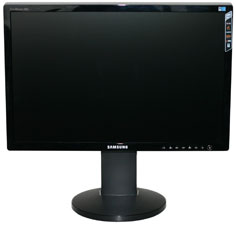 |
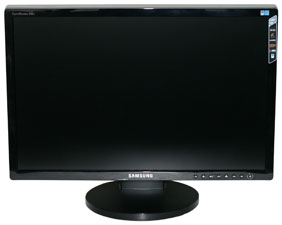 |
At the bottom right of the LCD, there are six buttons for accessing the on-screen display (OSD). Skipping the power button at the far right, which functions exactly as you would expect, the left button is a shortcut for enabling/disabling MPA. MPA stands for "Motion Picture Acceleration" and enabling it hopes to improve pixel response times. We'll find out later if it actually makes any noticeable difference in gaming as well. The second button brings up the main menu, and the next two buttons navigate through the menus. Pressing the menu button also exits out of submenus, while the fifth button (Source) acts as an enter button. When no other menus are active, the third button is a shortcut to cycle through the seven available color modes: Custom, Text, Internet, Game, Sports, Movie, and Dynamic CR. The fourth button also functions as a quick access to brightness levels, and the source button switches between available inputs -- note that if nothing is connected to an input, you can't switch to it without going through the full OSD menu. The Auto button is only useful in analog modes, where it will auto-adjust the screen size and centering, and the final PIP button turns on/off picture-in-picture.
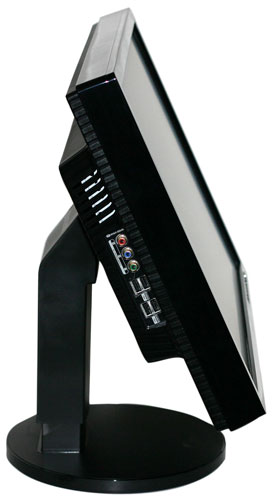 |
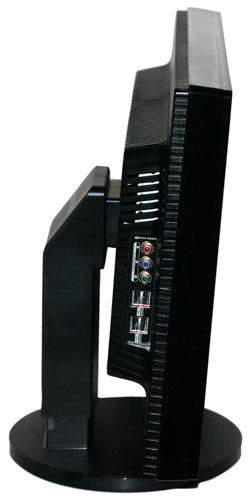 |
 |
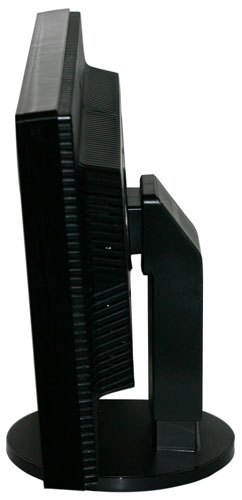 |
As mentioned earlier, the 245T supports the usual assortment of tilt, pivot, rotate, and height adjustment functions. You can see the range of motion available in the above images.
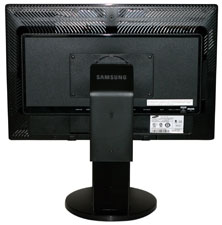 |
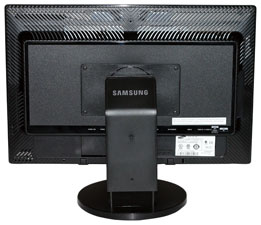 |
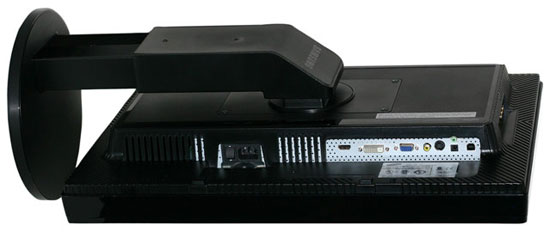 |
Most of the input ports all face downwards on the back of the display. The exception is the component input ports, which are on the left side of the display next to the four USB ports.
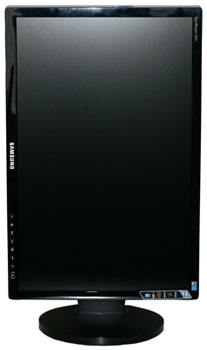 |
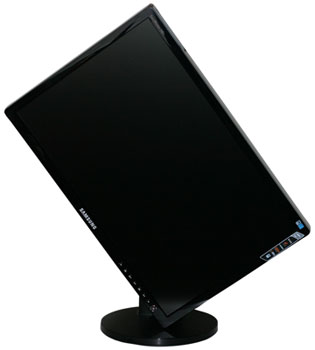 |
One nice feature of the stand is that it does allow you to raise the panel high enough that it can easily rotate into portrait mode. With some LCDs, we have found that you have to tilt the panel backwards as well as raising it to maximum height before you can rotate the display. If you find yourself frequently using portrait mode, the Samsung 245T would be a very good choice. Note also that the lack of cable management makes it easier to pivot the display.
We created a gallery showing all of the OSD menus and submenus, which you can access below. Most of the OSD functions are straightforward, but there are a few items worth pointing out.
First, there are multitudes of color adjustment options available. Not only can you adjust RGB levels, but you can also tweak hue and saturation via six color controls. We tend to find that amount of control more overwhelming than anything, but it's easy enough to ignore it and if you actually need such functionality it's there. Unfortunately, the second noteworthy item is a black mark; panel resolution scaling only offers two options: Wide or 4:3. "Wide" would be more appropriately named "stretch", as it will attempt to stretch any resolution to fill the entire screen -- without regards to aspect ratio. 4:3 on the other hand will fit any resolution into a 4:3 aspect ratio -- including 16:9 and 16:10 aspect ratios, even digital ones. What this all means is that sticklers who want 16:9 films not stretched vertically will be out of luck; similarly, people who connect an Xbox 360 or PS3 may be disappointed with the slightly stretched widescreen resolutions. What's missing from the scaling options are 1:1 (i.e. no stretch at all, giving black borders on all sides at lower resolutions) and proportional scaling (i.e. a 720p input would scale to fill 1920x1080, leaving black borders on the top and bottom edges) -- both of which are found on competing LCDs.
Update: The aspect ratio options are similar to what we found on the Samsung 2493HM when using the other input sources. In other words, 1:1 stretch is available on VGA connections. We no longer have the LCD, so we can't test the other inputs, but you can read the Samsung 2493HM review for more details.
















60 Comments
View All Comments
daarrid - Wednesday, August 13, 2008 - link
First, I'd like to thank Jarred Walton for his excellent review. A great deal of work goes into such a review. So, first and foremost, thank you sir! I'm also impressed by your timely follow-ups to the comments that have been posted.I just purchased the Samsung 245T (August, 2008). The firmware evidently has changed because there are new scaling options.
I'm only using two inputs - the VGA for various computers connected to it via a KVM and a Sony Playstation via the HDMI.
The VGA input now shows three options for size: wide, 16:9 (this is new), and 4:3. Wide is the only useful option (it appears to be 1:1 pixel mapping). The other two options distort the display. Why 16:9 was added as a choice is hard to say because it adds no useful function I can think of.
However on the HDMI input (and perhaps the DVI - I didn't test the DVI input) we have the old choices - Wide, 16:9, 4:3 and a new one! The new one is called "Just Scan" which seems to be 1:1 pixel mapping. Samsung evidently is listening.
bobo51 - Thursday, June 26, 2008 - link
I find it interesting that 4 months after Jarred was reassured by his contact at Samsung that this panel was a PVA, it is still speced as a TN panel on the Samsung website. And the mail order websites that report this characteristic seem to just parrot what is on the Samsung website.It would seem that it being a PVA unit would be a marketing point that Samsung would want to be front-and-center in their specs and advertising. So why isn't it out there?
Does anyone have any written documentation or labeling on the back of a unit (or anything other than someone's statement) that this is a PVA panel?
maxdog - Friday, August 22, 2008 - link
All of the 24" panels on the Samsung website state the same type. I'd like to know for sure.TrinityJayOne - Saturday, June 7, 2008 - link
Just thought I'd point out that there's an error in this review regarding display modes. It's true that there's no 1:1 pixel-mapping, but there IS a 16:9 option, it just isn't available when using a DVI source (I'm guessing because Samsung figure DVI = PC only and video cards support 16:10 resolutions). For HDMI, component, S-video etc, the 16:9 option will keep your 1080p signal un-squished and 720p will be upscaled. Check it out for yourself in the user guide, about 2/3 of the way down the page- http://downloadcenter.samsung.com/content/EM/20070...">http://downloadcenter.samsung.com/conte.../200707/...XrayDoc - Wednesday, April 2, 2008 - link
The new Dell 2408WFP has been available for perhaps a month. When are we going to see a killer review on AnandTech?machspeed5 - Saturday, February 16, 2008 - link
Conflicting Information!!!Page 4 of this trustedreview of the 245T states "genuine 1:1 pixel mapping"
http://www.trustedreviews.com/displays/review/2007...">http://www.trustedreviews.com/displays/.../2007/11...
".....A tonne of connectivity only adds to the appeal, as does the genuine 1:1 pixel mapping from 1080p sources."
This Anadtech review clearly states the opposite!
Who is correct here? Clarification appreciated, as you've thrown a monkey wrench in my purchasing decision! :P
Thanks
machspeed5 - Saturday, February 16, 2008 - link
found this:source: http://www.hardforum.com/showthread.php?p=10319083...">http://www.hardforum.com/showthread.php?p=10319083...
According to the User's Manual:
- if the video source is connected through PC/ DVI, you will be able to switch the size between "Wide" and "4:3";
- if the video source is connected through Composite/ S-Video, you will be able to set the size to "Wide", "16:9", "Zoom1", "Zoom2" or "4:3";
- if the video source is connected trough Component/ HDMI, you will then be able to choose the size between "Wide", "16:9" or "4:3".
Supposedly, by "Wide", they mean "Full screen" (1920x1200).
I don't really know what they mean by "Zoom1" and "Zoom2", but I guess this is some scale of "expansion" (by keeping the aspect ratio). But I insist, this is just me guessing; I do not own the screen.
As matter of fact, this leads also to the conclusion that there is no pure "1:1 pixel mapping" for all resolutions, even if you can get such pixel map for a HD 1080 lines source if you choose the "16:9" size.
can you confirm please, & perhaps update the review? many thanks.
JarredWalton - Saturday, February 16, 2008 - link
I checked the VGA and DVI connections... I didn't consider that they would add options on other inputs (most OSD controls gray out disabled options rather than removing them completely). I'm trying to come up with some meaningful "input lag" testing -- internal image processing lag would be more appropriate as a description -- so I'll see about testing the Component/HDMI/S-Video as well.Not surprisingly, I've got other things to review as well, so it might be a couple weeks before I get around to testing this.
machspeed5 - Sunday, February 17, 2008 - link
thanks.looking forward to seeing the input lag & HDMI pixel mapping options on the 245T. :)
word on the street is that the input lag is pretty bad, ~50ms, (2.5 frame lag.)
from my readings, 50ms (while on the upper end of laggy displays) may still be usable for all but the most time-sensitive games. (fps specifically) a lot of people complain and overrate the input lag problems on forums, though it's evident few understand what it is. (even confuse it with response time)
i'd appreciate hearing your opinion on the matter. I plan to use a PS3 with the 245T, and FPS will certainly be in the machine from time to time.
Genuine 1:1 pixel mapping is also important to me, and if you could clarify the issue here i'd be much appreciated.
cheers
Thetruepit - Monday, February 11, 2008 - link
It does suffer from inverse ghosting.Most noticeable in gaming mode so I don't use that.
Surprised it wasn't picked up. Also if you move your mouse cursor over a grey background you see noticeable ghosting.